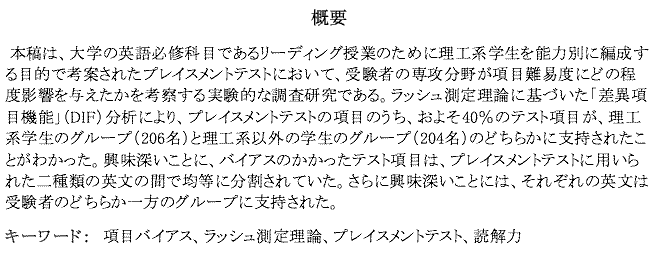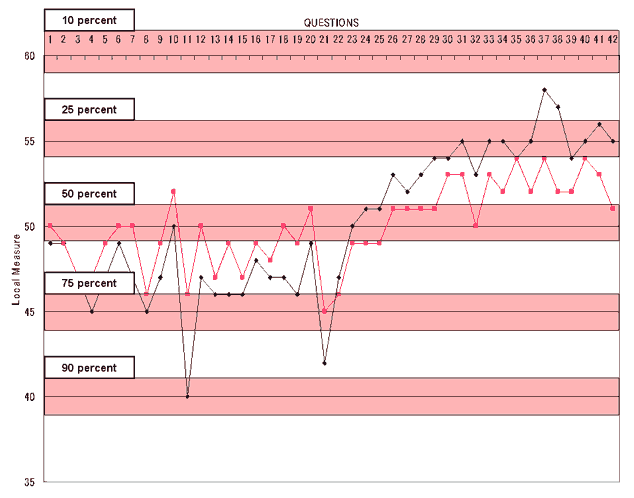May. 12 - 13, 2007. Sendai, Japan: Tohoku Bunka Gakuen University. (pp. 84 - 96)
|
|
Keywords: Item bias, Rasch measurement theory, placement examination, reading comprehension  |
|
|
Keywords: Item bias, Rasch measurement theory, placement examination, reading comprehension  |
| ". . . institutions interested in a placement examination tailored to the specific needs of their language program are better off committing to the challenging, yet possibly rewarding journey of developing their own test items." |
[ p. 84 ]
Participants| Nobel Passage | DNA Passage | |
| Number of words | 367 | 356 |
| Number of sentences | 19 | 16 |
| Average length of sentence | 19.32 | 22.25 |
| Flesch | 45.23 | 44.28 |
| Flesch-Kincaid | 11.75 | 12.61 |
| 1000-word level | 0.77 | 0.76 |
| 2000-word level | 0.07 | 0.07 |
| Academic Word List | 0.07 | 0.05 |
| Off-list words | 0.10 | 0.12 |
[ p. 85 ]
[ p. 86 ]
Analysis| "The CHIP scale is a useful way of conceptualizing the probability of test takers' success." |
| 60 chips | 55 chips | 50 chips | 45 chips | 40 chips | |
| .10 probability | .25 probability | .50 probability | .75 probability | .90 probability |
[ p. 87 ]
Results| Text | Item type | DIF Contrast | Probability Contrast | Favoring |
| Nobel | Literal | -3 | 0.16 | Science |
| Nobel | Organizational | -5 | 0.17 | Science |
| Nobel | Organizational | -2 | 0.13 | Science |
| Nobel | Organizational | -3 | 0.14 | Science |
| Nobel | Inference | -3 | 0.19 | Science |
| Nobel | Inference | -2 | 0.13 | Science |
| Nobel | Inference | -3 | 0.11 | Science |
| DNA | Organizational | 3 | 0.13 | Non-Science |
| DNA | Organizational | 4 | 0.15 | Non-Science |
| DNA | Organizational | 3 | 0.14 | Non-Science |
| DNA | Inference | 3 | 0.15 | Non-Science |
| DNA | Inference | 4 | 0.16 | Non-Science |
| DNA | Inference | 5 | 0.20 | Non-Science |
| DNA | Inference | 3 | 0.11 | Non-Science |
| DNA | Inference | 4 | 0.19 | Non-Science |
[ p. 88 ]
| "One interesting pattern . . . is that the items favoring the science and the non-science majors were split between the two reading passages." |
[ p. 89 ]
| Factor examined | Major | M | SD | Significant? |
| Nobel Knowledge | science | 4.04 | 0.96 | * |
| non-science | 3.73 | 0.96 | ||
| Nobel Difficulty | science | 7.00 | 1.71 | |
| non-science | 6.73 | 1.79 | * | |
| Nobel Relevancy | science | 4.84 | 1.43 | * |
| non-science | 4.38 | 1.30 | * | |
| DNA Knowledge | science | 4.40 | 1.37 | * |
| non-science | 4.11 | 1.35 | ||
| DNA Difficulty | science | 6.61 | 2.19 | * |
| non-science | 6.17 | 2.29 | ||
| DNA Relevancy | science | 4.76 | 1.79 | * |
| non-science | 4.17 | 1.67 |
[ p. 90 ]

[ p. 91 ]
[ p. 92 ]
[ p. 93 ]